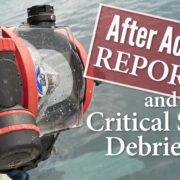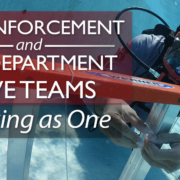Name: Sean Hidalgo
From: Stockton CA
Work: City of Stockton Fire Department
ERDI: Thanks for taking time from your day to talk with us about your experience in Public Safety Diving. Lets get right into it Sean and tell me a little bit about yourself
Sean: I’m from Stockton California and I am a Fire Captain with the City of Stockton fire department.
ERDI: Can you give us a little about your background in diving?
Sean: My background in diving basically started here on our dive rescue team. The first time I started diving was when I became a team member back in 2000 and from there I progressed on to instructor in 2002 with another agency and then quickly crossed over to an SDI and ERDI.
ERDI: You’re actually in a unique position from most public safety divers in that you wanted to join dive team even though you were not a diver at the time.
Sean: Yes, the way it happened was our recruiting department had a couple specialty programs open up, one of them being on a dive team. There is a selection process that includes swim tasks and an interview process before we go into open water and then the rescue dive training. So it is a little different but wearing a full face mask underwater with zero vis is not too big of a transition from fighting a fire with no visibility wearing a full face mask. So for me, it was an easy transition and that was how I got my start into public safety diving.
ERDI: that’s really cool, now since you got your start this way, do you go on recreational dives just for fun?
Sean: Yes, I do a few classes here and there and have also enjoyed teaching friends and family of the fire department and some of the kids including my boys. Both my boys are certified. And as far are recreational dives, it’s usually when we are on vacation. Recently we dived in Hawaii while on vacation and most recently in Cabo San Lucas. And every once and a while, we dive around here in the rivers to look for good spots for training exercises, but most of my diving is on duty.
4:30minutes into interview
ERDI: What types of public safety are you involved in?
Sean: There are 2 things we deal a lot with in Stockton. Zero visibility, you know the kind where you can’t even see your hand when its right in front of your face and the second thing we deal with is contaminated water. We have a large delta area that we cover, so anywhere around there we have a lot of exposures to pesticides and heavy metals from a old military base. so we are always prepared with fluids on the truck.
We are a 99% pure rescue team. When 911 is called about someone in water, we are the team they call. From the call we have an hour to attempt a rescue. Depending on the situation and what we have, we usually stay longer just to find the vehicle or person and help the local DART recovery team.
ERDI: What team exercises does your team do to stay sharp?
Sean: Most our training revolves around zero vis, so when in the pool, we practice with black out masks. We also have some mock vehicles we built to use in the pool for entanglement drills and confined spaces. We try to construct real scenarios with life size vehicles and challenging obstacles so when the phone rings, we are prepared.
ERDI: That’s sounds like good fun training. When its time to add dive members to your team, what is that selection process like?
Sean: We don’t necessarily look for certified divers, but I do have divers that I teach off duty that want to join the team. To me, recreational diving is very nice if we mess up on something, we talk about it, you know, we are the good guys as the instructor. Whereas for the dive team, when we teach open water, we are the bad guys. We hammer in skills in because our open water course is a lot longer than the recreational because we expect more. We go into dive sociology and explain dive tables and the idea of gas log so we can deal with a dive emergency.
The biggest qualities we look for are personality, attitude and confidence in the water.
ERDI: Give us a scenario of a daily routine for your dive team
Sean: We are a fire company first and water rescue is our specialty. First priority is to set up gear on the fire engine and once everything is on the rig, we set up the water rescue to be ready by 8am. Each day varies, but a typical day may include taking out the watercraft to make sure it running or pool training.
ERDI: Do you have complacency and what do you do as a team to avoid it?
Sean: Ensuring every morning when you come on duty, you check everything. You check your tanks, hoses, mask and of course our fire engine. And it’s the same thing with the water rescue. As the captain, I usually go through everything again too. Complacency is an evil and we’re doing good, knock on wood.
ERDI: What value do you place on the Public safety dive training?
Sean: We look for a curriculum that meets our local NFPA Standards. These are the standards that most dive rescue teams follow. We also look at real word training and experience.
ERDI: one last question Sean, How does Public Safety equipment differ from recreational dive equipment?
Sean: Diving is inherently an equipment intensive sport. We are a different breed from recreational and technical divers. We mostly carry full face masks and some type of hazmat certified drysuit. Every once and a while you do find rec or tech divers with full face mask, but rarely. And you do find them wearing drysuits, but they are typically tri-laments that are nice and comfortable.
A lot of guys have surface supplied air, pony bottles or some type of back up air supply. When I dive in Hawaii, I have a BC, tanks, mask and a snorkel; I try and keep it simple and streamlined.










